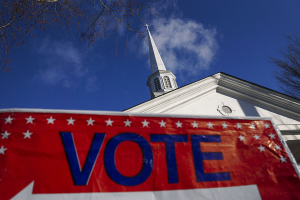Tithing Hits Record Low; Churches Spend More to Make Congregants Happy
Tithing, Church Giving Hits All Time Low Since 1960s
Are churches spending more on themselves than on the needs of those outside the church?
According to a new report they are, with churches keeping a larger share of their tithe-generated income for their own in-house needs.
In a report, titled “The State of Church Giving Through 2009,” released Friday by Empty Tomb inc., a Christian service and research organization, authors found that “benevolences” – or funds used for giving outside the church including giving to charities and seminary training – hit new lows compared to their first report in 1968.
Understandably, with the tithing amount greatly reduced over the past few years because of a bad economy, a drop in benevolences was only normal.
The report, which used data from evangelical and mainline churches including Lutheran, Presbyterians and Episcopalian churches, in fact revealed that tithing as a percentage of income was at its lowest level in 41 years, Religion News Service noted.
Parishioners were only giving about 2.38 percent of their income to the church in 2009, down from 2.43 percent in 2008 – shockingly low percentages.
“If Americans who identify with the historically Christian church had chosen to give 10 percent to their congregation in 2008, rather than the 2.43 percent given that year, there would have been an additional $172 billion available for work through the church,” the Empty Tomb website noted.
Though the greatly reduced tithing rates garnered much attention, what remained more surprising to the authors was the church’s distribution of parishioner income. While only 0.34 percent went toward benevolences, over 2 percent was used on congregational finances.
If the percentage of income for benevolences was at the level it was back in 1968 – 0.66 percent – there would have been an additional $3.1 billion in benevolence giving.
“Churches on the whole are continuing to spend more on current members and less on the larger mission of the church and cutting back on missionaries,” Sylvia Ronsvalle, Empty Tomb’s executive vice president, told RNS.
She and her husband, who co-authored the study, worried that churches were not being more generous toward outside giving, thus concentrating less on charities, the lost and the dying.
Ronsvalle shared that in 16 impoverished nations, 10 of them primarily Christian, little to no progress was seen in improving child mortality rates, a problem she believed could be resolved if churches contributed more.
If members contributed only a few more cents per day, churches in the U.S. could stop up to two-thirds of global under-five child deaths and engage every unreached people group, the authors previously found.
An estimated $239 per evangelical Christian could potentially stop global deaths of children under five while only $26 a year could fund over $544 million in efforts toward global evangelization.
“These babies do not have to be dying, and yet nobody is mobilized at a scale that would achieve that solution,” Ronsvalle stated. “Contempt for death isn’t the way to expect a Christian to live their life. We ought to be sacrificing, we ought to do everything in our power to make sure everyone that wants a Bible can have one.”
By increasing tithing to 10 percent, parishioners could help provide much needed relief efforts around the world and contribute to the end of many of the world’s greatest problems, while still maintaining their own church activities.
But the “lukewarmness” of the church in the United States and not a lack of resources or methods posed serious consequences to both global evangelization and the end of physical suffering, the authors had previously stressed in their reports.
If a church is turning inward and valuing the happiness of its members over service to others, it is moving on a spectrum toward pagan values, the vice president also stated.
“That’s an offensive question even to raise, but if we are moving in that direction we need to see it now. These are alarming trends that need to be evaluated.”
Many pastors, theologians, and church leaders have also echoed Ronsvalle’s concerns about tithing and generous giving, as tithing continues to drop amid the recession.
Earlier in the year, Barna Research Group found that only 4 percent of Americans gave 10 percent of their income to churches, a drop from the previous year’s rate of seven percent of Americans.
A quarter of Americans even stopped giving altogether to churches. The president of Barna Group commented that as the recession kicked in, people began cutting back their giving to churches and nonprofits. And even when the economy started to show signs of improvement, they were reluctant to return to their previous levels of generosity.
“If ... the church in the U.S. ... should opt to be earnest and repent, then the church will reflect a change of heart as evident in increased concern for others, displayed through increased church member giving for the purpose of helping others who are in desperate need,” Ronsvalle maintained previously.
Jordan J. Ballor, a Ph.D student at Calvin Theological Seminary, discussing the issue of tithing, expressed before that if American Christians were to focus on the simple obedience of giving back to God what is really His in the first place, the church would have the resources to do great things, like the Empty Tomb study indicated.
But he believed that parishioners should not give because of the good it would accomplish for the church, others, and themselves, but ultimately because “the Bible tells us so.”
To purchase a copy of the latest study by Empty Tomb Inc. click here.




























